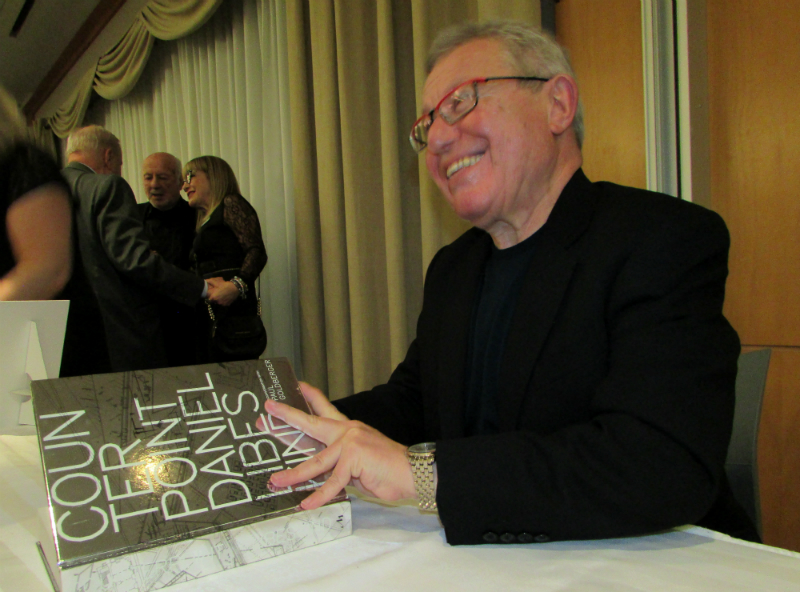Daniel Libeskind, the master planner of the reconstructed World Trade Center (WTC) in New York, says his No.1 priority was to make the 16-acre wasteland at Ground Zero into a pleasant, functional public space.
Libeskind, a celebrated international architect, won the open competition to redevelop the site in 2003. His design is being realized in co-ordination with three levels of government, as well as the port authority and the architects of the individual buildings.
Together, they continue to try to balance memorializing the 9/11 tragedy with the creation of a desirable place to live and work.
“It’s the most complex project I’ve worked on,” Libeskind, the author of Edge of Order, said during a speech at Jewish Public Library in Montreal on Nov. 6. “Everyone had very different ideas on what to do.”
Fully one-half of the acreage is defined as public space, including the memorial and museum dedicated to the victims of the attacks, with the office towers being set back as far as possible, he said.
In addition, two new major public facilities were incorporated: a transportation hub and a performing arts centre.
One World Trade Center, which rises a symbolic 1,776 feet (the date of U.S. Declaration of Independence), opened in early 2015, and 3 World Trade Center was completed last year.
The final skyscraper, 2 World Trade Center, is currently under construction.
Libeskind drew particular attention to a feature of the underground Memorial Museum, which opened five years ago. He takes much satisfaction in having been able to retain the slurry wall that holds back the Hudson River. The dam, which extends about 25 metres down to the bedrock, withstood the destruction of the WTC, avoiding even greater catastrophe.
To Libeskind, that wall is a testament to the strength of America’s democratic foundation.
That the master plan is still unfolding 16 years later is a testament to the fact that “this is truly a public work,” he said. “Most original plans are abandoned after five years, as political and economic conditions change.”
The project was delayed by one year because of a disagreement among the stakeholders over how to secure the site, he added. “We do not want to create a closed city.… We want to create a safe and secure environment without making walls in the city.”
Getting that right has profound significance for Libeskind, as was the first project of his architectural career, Berlin’s Jewish Museum, for which he won the design competition in 1989.
Born in 1946 in Lodz, Poland, to Holocaust survivors, Libeskind recalled arriving by boat in New York in 1959 with his family.
“It’s hard to imagine seeing that skyline for the first time from that perspective. It represented the power and vitality of democracy,” said Libeskind. “That’s America.”
At 73, the affable and unpretentious Libeskind is busy working on several projects around the world, altering cityscapes with his signature dramatic, sculptural buildings.
Two are far from urban and express Libeskind’s own concerns. The Kurdistan Museum in Erbil, Iraq, was commissioned by the Kurdish people to document their 8,000-year history in the region. The genocide of the Kurds perpetrated by the Iraqi government between 1986 and 1989 is a special focus of the museum.
Libeskind regrets the Trump administration’s “betrayal” of the Kurds with the withdrawal of U.S. troops from Syria, but thinks they have “an indomitable spirit that will never be subdued.”
The second project he highlighted is a museum in Kenya, which he is working on with famed paleontologist Richard Leakey. An edifice that is reminiscent of a primitive stone axe and its flint will rise 80 metres along the edge of the Rift Valley, where Leakey has been searching for fossils for five decades.
Libeskind was inspired by the genius of the early human who first thought of making a sharp edge by knocking two stones together.
Leakey wants to send the message that humans are destroying the Earth and all must join in reversing that.
“I don’t believe we’re doomed. We have the technology to address many problems that seem intractable,” said Libeskind. “But it depends on political action. If you have a president who does not believe in science, it’s very difficult.”
Libeskind is no stranger to Canada, having been responsible for the National Holocaust Monument in Ottawa and the Royal Ontario Museum’s Crystal extension, among others.
He has also been married for 50 years to Canadian Nina Lewis, daughter of the late NDP leader David Lewis and sister of Stephen Lewis.
Although not an architect, Nina Lewis has been his constant collaborator, providing perspectives that those bound by architecture’s conformity do not have, he said. “I would not be standing here if Nina were not my boss.… I told her if you go into politics, I’m closing my office.”
